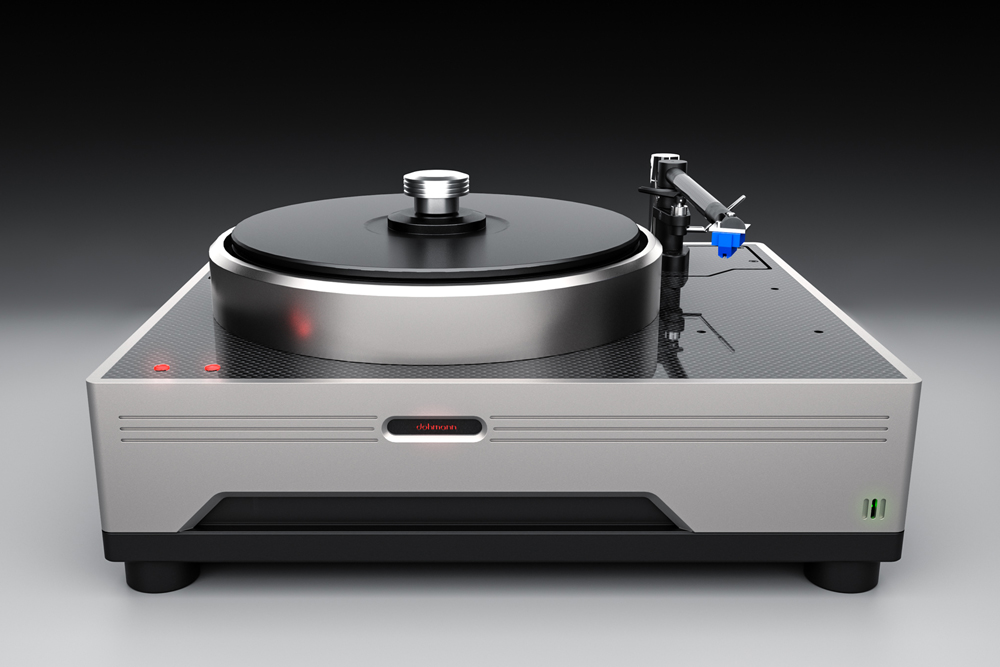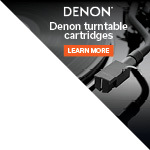Over a decade ago, as vinyl began its unstoppable bloom, I had the privilege of being one of the first reviewers to enjoy a private audition of a new revolutionary Australian über high-end turntable. That landmark product was the Continuum Caliburn and it subsequently rocked the top-end-of-town in analogue playback. A collaborative creation, the Caliburn was the offspring of advanced engineering by some of the best specialist minds in the industry. At that session, I interviewed one of its key designers, Mark Döhmann, who generously shared detailed insights while also enlightening me on the profound and innovative engineering he applied across many aspects of that unique product. Now, after much water under the bridge and having risen Phoenix-like, Döhmann returns with a new endeavour and yet another innovative design which promises, once again, to elevate analogue playback around the globe.
In Orbit
The first product Döhmann Audio introduced was the flagship Helix One now followed by Helix Two, the newest addition to the company’s stable. The two ‘tables share many design aspects, of course, not least the floating architecture of both platter and armboard. Although the Helix Two may be a somewhat downscaled version of its up-tier sister product, there is little, if any, noteworthy compromise.
In fact, the Helix Two is super solid both physically and in terms of its considerable engineering. Once again, Kyron Audio’s talented Lee Gray stamped his moniker on the Helix Two’s industrial design, post his terrific effort on Helix One. The gifted Grey has managed to carry across aesthetic design cues used on Helix One and adapted them to the smaller sibling while being mindful of Mark Döhmann’s engineering requirements. There are commonalities in DNA making for Helix Two’s recognisable styling as part of the Döhmann family.
The Helix Two is a dual belt-driven design using a massive high torque Swiss-manufactured motor. It accepts one tonearm of up to 12 inches. Being custom software-driven, a mini-USB port on the turntable’s underside allows computer connectivity in order to adjust a number of parameters. Aside from speed control refinements, the software can adjust revolution stop/start timing, etc. These settings are set-and-forget.
Designer Mark Döhmann visited the day after the ‘table was safely delivered in its high quality road case. The road case provides safe passage for the units’ travels while also snuggly accommodating all the accessories within bespoke compartments. A very nice touch: all Helix Two turntables ship with a small bottle of Tasmanian Sullivans Cove Single Malt Scotch whiskey. Not saying it was consumed in a blazing gulp before the ‘table reached 33rpm but it was close… Smooth.
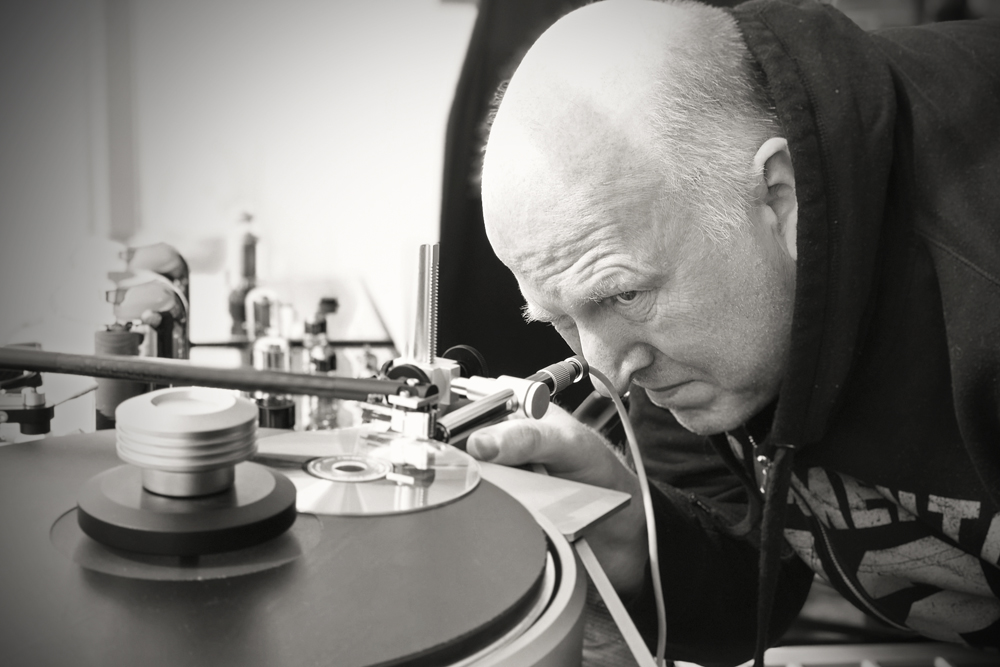 Digital in aid of analogue: Sharpshooter Mark Döhmann aligning things to perfection.
Digital in aid of analogue: Sharpshooter Mark Döhmann aligning things to perfection.
Döhmann spent considerable time adjusting all parameters of the Schröder CB Carbon Fibre arm (AU$8000) and My Sonic Lab Signature Platinum cartridge (AU$17,786) provided for this review while also generally making sure all aspects of the Helix Two were AOK. Regarding tonearm options – while Döhmann Audio recommends the Schröder arm, the company is happy to quote on bespoke armboards for your preferred tonearm (Döhmann Audio states on its website that popular arms from companies such as SME, Kuzma, Graham Engineering, etc. have been successfully used with Helix One and Two).
I took the opportunity to ask both Mark Döhmann and new business partners George Moraitis and Jim Angelopoulos – both experienced audiophiles, music lovers and entrepreneurs with a strong vision for the company – several general questions followed by some more specific ones relating to the Helix Two’s ideologies and their juxtaposition with regards to Helix One.
In order to achieve the sound quality that we strive for, we have implemented the same technologies into both models. In the Helix One, we have simply taken the implementation of those technologies to a higher, more extreme level. This is great news for owners of the Helix Two because it contains all of technologies that are unique to Döhmann turntables. The Helix Two shares the MSA Micro Signal Architecture with the Helix One platform. This includes the full Minus K technology-sourced custom Negative Stiffness Isolator built to fit inside the chassis of the Helix Two.
The TDS Tonearm Damping System using PAR PreStress Accumulation Release has been adopted and implemented inside the Helix Two and the bearing and platter design is also identical to the Helix One platform. The twin durometer belt drive system is also identical to the Helix One platform and the chassis design uses the same multi-plate technology as the Helix One. As a result, both models exhibit the sonic characteristics that the Helix turntables are renowned for.
Being Australian designed, I wondered what level of local manufacturing applied to Helix Two…
Döhmann Audio has steadily progressed towards full Australian-based manufacturing. Our motors are Swiss-made to our specifications by a specialist high-end motor specialist and our isolation platforms are made by Minus K in the USA to a special design which allows total integration with the turntable and the tuned resonance dissipation plates. These will remain the only internationally sourced parts. At the moment, we still have some steel legacy parts coming in from Thrax Audio but that is coming to an end soon. We are fortunate to have established relationships with leading Australian partners who have the same obsession for quality that we do. Our alloys are sourced from aeronautical grade suppliers with local defence department approved MILSPEC plating suppliers providing the required surface finishing.
Our Carbon Fibre parts are sourced from highly skilled (ex-Formula One Mercedes Arrows Team trained specialists) carbon fabricators in Melbourne. This move back to a single Australian facility makes it possible for all Helix owners globally to be able to interact with a single point of contact for service and support.
Seeing his recent coming on-board as an owner and CEO, I asked Moraitis what his plans and aspirations for Döhmann Audio were going forward.
When I first heard a Döhmann turntable, apart from the sonic ‘wow factor’, I felt immensely proud that a very small Australian company was creating products that were considered to be at the very top of their genre. I discovered that due to economic reasons, Mark was designing turntables that were then being made in and distributed from the Thrax Audio factory in Bulgaria. It was important to us that our turntables were made in Australia, so my first project was to transition the manufacturing from Bulgaria to Australia. We have now almost completed this transition. We source our motors from Switzerland, our isolation mechanisms from the USA, however all other aspects of research, testing, manufacturing and assembly are now carried out at our new facility in Melbourne and this has resulted in the employment of Australian people making an Australian product. Our next focus is to create a great ownership experience for our clients and cement Döhmann Audio as a premium brand. This includes aspects like sonic performance, reliability, customer support and an upgrade path which ensures that our clients’ turntables remain at the top level of performance available. Our turntables are considered to be heirloom pieces and we are very proud that we rarely see a Döhmann turntable for sale on the second-hand markets around the world.
If I was asked to describe the spirit of our company in one word, I would say ‘innovation’. The team is perpetually identifying possible areas for improvement and then trying out different technologies, listening to the results and refining. This approach is resulting in the standards being set even higher and it will be what we continue to do in the future.
With Moraitis’ now sharing the leadership, opportunities now present themselves for Döhmann to dedicate more time and focus on design and product engineering. I asked Mark Döhmann what are the near future plans, product wise, for the company and are there plans for non-turntable-based products?
The arrival of George Moraitis and Jim Angelopoulos in November 2018 has resulted in unprecedented progress for Döhmann Audio. I am now able to exclusively focus on product development and manufacturing. One of our strengths has been our engagement with the wider scientific research community. I have now been able to develop relationships with some universities and engineering research firms, which is providing us with information, research and resources which will continue to drive the sonic breakthroughs Döhmann Audio are recognised for. Several new innovative products are under development at the moment which will extend our product range and capabilities into new markets. These are exciting times!
Finally, I asked opinions on what analogue playback offers that perhaps digital playback doesn’t?
This is an interesting question and brings into play subjective experiences and factors such as each person’s individual sensitivities, listening preferences and tastes. Digital playback at its best is much better now than it has ever been, however in our opinion, analogue playback continues to offer some significant advantages. In our experience, well-designed analogue facilitates a deeper level of engagement with the artist’s message. It has an uncanny ability to sound more natural and connect us more effectively with human emotions. It must happen on a deeper chemical level inside the human brain. A great analogue system exposes the micro-detail, nuances and timbrel elements of music and voices in a way that makes it more ‘believable’ so it is easier to stop ‘thinking’ and just ease into the flow of the music.
Over the years, we have spent countless hours listening to music with friends, enthusiasts and clients all around the world. Real music lovers who just want to get a great sound and don’t care in the moment which format is being used. We have often observed that the listening sessions that go the longest and that people remember more are with the analogue sources. Putting all the technical aspects aside, we feel that analogue is simply more real, believable and ultimately more emotionally satisfying.
A Plus 4 Minus K
The Helix Two is based on a Minus K anti-vibration fully-floating platform which has been incorporated into the ‘table chassis’ innards and has been designed to work in conjunction with a number of additional technologies. Externally, the look is of a massive plinth structure supporting the platter. While the rectangular shape may make Helix Two seem rather conventional in terms of its form factor, there are several engineering aspects which make it a rather unusual and deceptively complex design. For starters, the plinth itself is CNC machined from solid aluminium, weighs 50kg and is connected to the Minus K system via a series of tuned interlocking plates.
The Minus K itself is a system used by a wide range of high-tech industries including organisations in the aerospace (including NASA), medical, scientific and research spaces and many more. Minus K’s Negative-Stiffness Vibration (NSV) isolation technology combines a specific custom spring system with the company’s Negative-Stiffness Mechanism (NSM). Minus K’s strategies encompass the combination of tilt-motion, horizontal-motion and vertical-motion isolation.
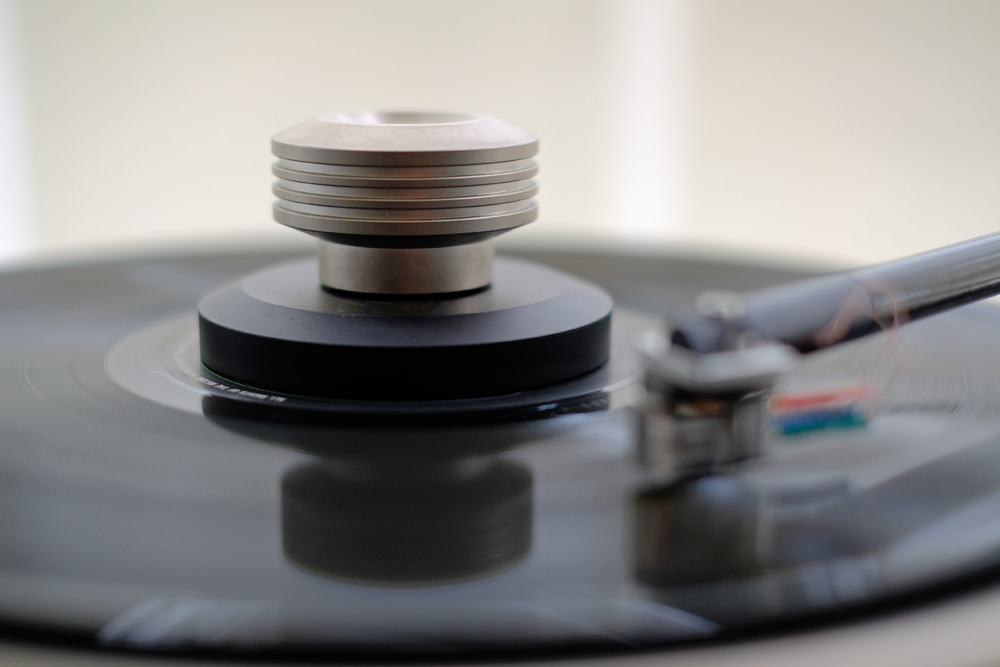
As far as the NSM acronym goes, the technology deals with the way certain materials “which are placed under load a force does not monotonically increase with displacement”, something referred to as “negative stiffness”. The Helix Two’s Minus K Technology isolation system employs negative stiffness “alloy flexures” to stabilise a single low frequency vertical coil spring to form a high performance Vibration Mitigation System without the need for air or electricity. The Minus K website features a wealth of technical information and white papers which thoroughly describe the philosophies and engineering behind the products. Many of these technologies have been adopted and modified by Döhmann Audio in order to implement them into the Helix One and Helix Two.
The Helix One employs a proprietary ‘Tonearm Damping System’ (TDS) solution which forms a semi-active damping system to further lower the noise floor of the overall system. The technology, used in early Döhmann turntables since 1985, is now further refined and uses a pre-stress accumulation release (PAR) strategy to mitigate vibrations inside the chassis caused by motor bearing and platter bearing noise. It creates a path of least resistance for vibrations, channels them away from the critical signal path zones and dissipates the energy.
The Helix Two is fitted with a strategy called ‘Pre-Stress Accumulation Release’ which constrains the relative slip between layers of plates. The strain accumulated in the structure locally is released as it occurs which results in conversion of a part of the strain energy to the kinetic energy of local, higher frequency vibrations. These higher frequency vibrations are then sunk into heavy damping materials which absorb and convert these to heat. Equilibrium is quickly restored to allow the structure to return to the initial state by means of a gradual release of the pre-stress accompanied by the frictional dissipation in the contact surfaces. This architecture is used as a Mechanical Crossover to selectively reduce each band of frequencies.
A Döhmann Audio-designed dual ‘Durometer’ belt arrangement drives the massive ‘Tri-Modal Platter’ system (TMP). In a cool kinda way, the platter smoothly ‘gives’ under downward pressure then gradually returns to its upper position as the Minus K comes into play. Its movement is masked by an aluminium surround matching the Helix Two’s chassis finish. The TMP system is basically a method of fabricating the 15kg platter in a way that controls resonance modes.
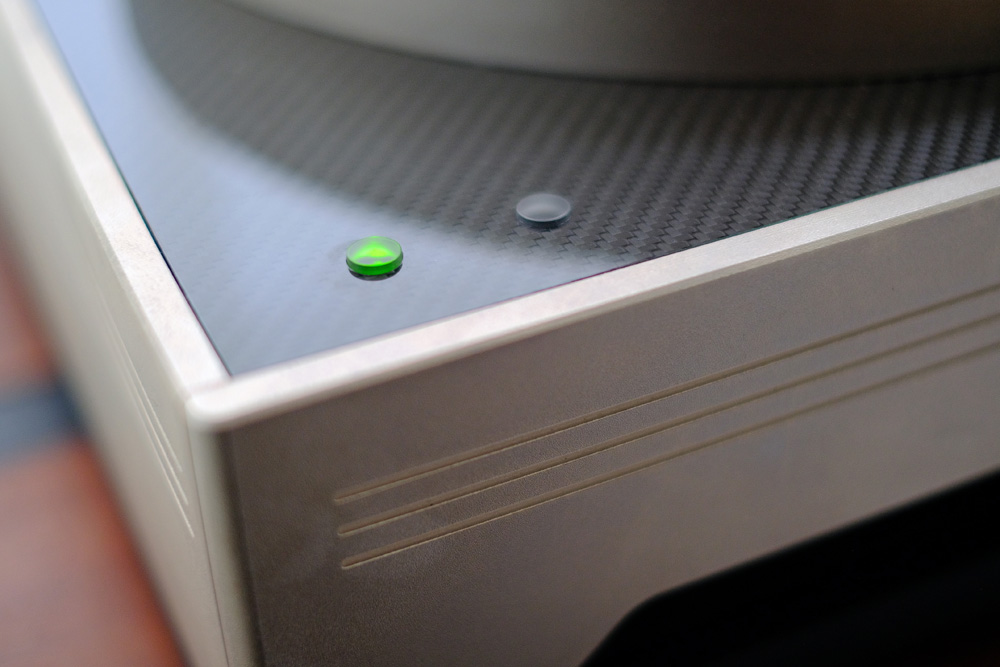
Micro Signal Architecture (MSA) is a design approach using advanced techniques in order to remove vibration and electrical noise, something that is fundamental to retrieving the smallest signals from the microgrooves in an LP.
The top plate is provided in black anodised aluminium while an immaculate gloss carbon fibre top plate can be ordered as an optional extra (AU$4560). Ditto for the armboard which is, again, anodised black aluminium with the composite and carbon fibre being an option (AU$4500). Post designing the ‘Advanced Composite’ and carbon fibre armboard, listening tests by Döhmann and Moraitis confirmed, to their surprise in terms of its extent, that there were substantial sonic benefits to the fibre option. Below, I state my views which concur with their own.
Moraitis’ and Döhmann’s findings are actually not that surprising considering the efforts and determination behind the design and construction of the carbon fibre armboard. Mark Döhmann summarised its design thus:
The carbon fibre armboard is a proprietary layup with final high gloss weave, specialised high damping material. It’s a high tensile shell plate in a proprietary weave of bullet-proof material constructed of custom polymer cross woven sheets in multiple layers. This is as used in ballistic protection plates and high tensile steel plate. Each plate is then pre-stressed in specific places to change the modal performance. This creates a major reduction in noise compared to contiguous cast materials.
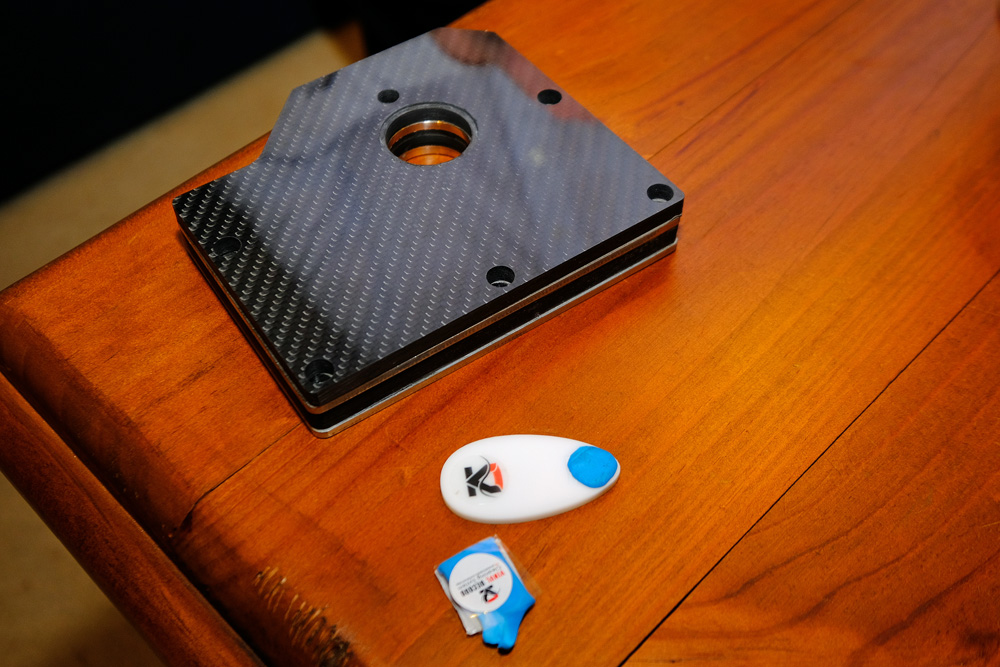 Carbon Fibre armboard upgrade shown here with Vinyl Record Cleaning Company's VRC Stylus Tip Cleaner.
Carbon Fibre armboard upgrade shown here with Vinyl Record Cleaning Company's VRC Stylus Tip Cleaner.
Helix Two features a high quality 1.5m captive dual RCA cable terminated with good quality Furutech connectors. Operating the Helix Two is child’s play. Basically, there are two dual-LED buttons on the platter’s left-hand-side which serve to activate the motor. Both buttons are backlit ‘red’ when the ‘table is inactive. Pressing each of the buttons lights them in ‘green’ and toggles between 33rpm and 45rpm (a 78rpm motor is available as an optional extra). The table then starts its revolution and reaches the selected speed in the time that was preset via the set-and-forget USB setup procedure. Stopping playback is a matter of pressing the corresponding button which in turn lights up red, with the platter going static, again, within the preset time. Oh, a heavy machined puck – in matching colour to the ‘table (nice touch) – screws on to gently downward-press your precious vinyl. And that’s all folks… Simple!
The review sample was provided in an attractive new ‘Titanium’ finish with an upcharge of AU$4500 over the standard – and also beautifully done – silver and black anodised. Overall, the Helix Two’s fit and finish standards are extremely high and, budget permitting, I would highly recommend the carbon fibre top plate option – it’s absolutely immaculately done and looks a million bucks.
Before I start on my listening impressions, there’s something that needs to be stressed in no uncertain terms: The Helix Two (and Helix One for that matter) is NOT a composite of a turntable sitting atop an integrated Minus K system. That oversimplification would be misrepresenting the overall design and engineering that went into creating the Helix Two and its suite of technologies (do yourself a favour and explore the ‘Technology’ page of the company’s website for a very enlightening read). As Moraitis put it:
When you place a turntable on a Minus K platform, it creates a new resonance pool (micro-environment) between the surface of the Minus K and the suspension system of the turntable. In our experiments, we measured these effects as having a destructive influence on the sound and led us to work with Minus K to design a mechanism that fully integrates into a turntable chassis, which eliminates this problem. Placing a Minus K under your turntable results in an improvement in sound quality however it does not compare with a Helix design. A Minus K only mitigates vibrations up to 100 Hz. There are many common resonances that occur above 100 Hz. Helix turntables are designed to accurately pass on all ground/chassis borne resonances >100 Hz to a system of tuned resonance plates that eliminate the higher frequency resonances, something that cannot be achieved by the simple placement of a turntable on a Minus K system.
My Sonic Lab
Some components have an overt quality which, all things being equal, I hone-in on from the get go; the Helix Two’s (H2) jumped at me straight away. And the word “jumped” is super appropriate here. The H2 has a rhythmic, propelling and toe-tapping ability which makes you feel like getting up and boogying along with it. It’s an expertly balanced aspect, however, because it’s not achieved via pulling or pushing of any frequency band but rather by controlling the low-end to a freakish extent. I’m talking bass that is super-tight and detailed with blinding transient attack at the notes’ leading edge.
The Beatles’ “Come Together” from Abbey Road’s recent 180g pressing presented that renowned hanging low bass note with power and superb definition while the thud of the kick drum pounds your chest. There’s plenty of skin-on-pedal-beater texture there, going a long way to tricking you into believing there’s a real drum kit in the room. Dynamic contrast was arresting, as was the oh-so-important beat-bopping boogie factor. This last, in particular, is no mean feat, as I’ve found many turntables lacking in this department, to varying degrees.
So there’s a broad textural richness to the Helix Two that applies across the bandwidth but if I may stick to the bass for just a tad… the refined Gold Note remaster of Ensemble Operarmonica’s Carillon LP showed the full spread, deep and high, of the superbly-captured organ. It was visceral. Having said that, the subtle delicacies of the accenting flute were easily discerned with timbrel beauty and fine nuance juxtaposed against the brutality and majesty of the full-blown organ.
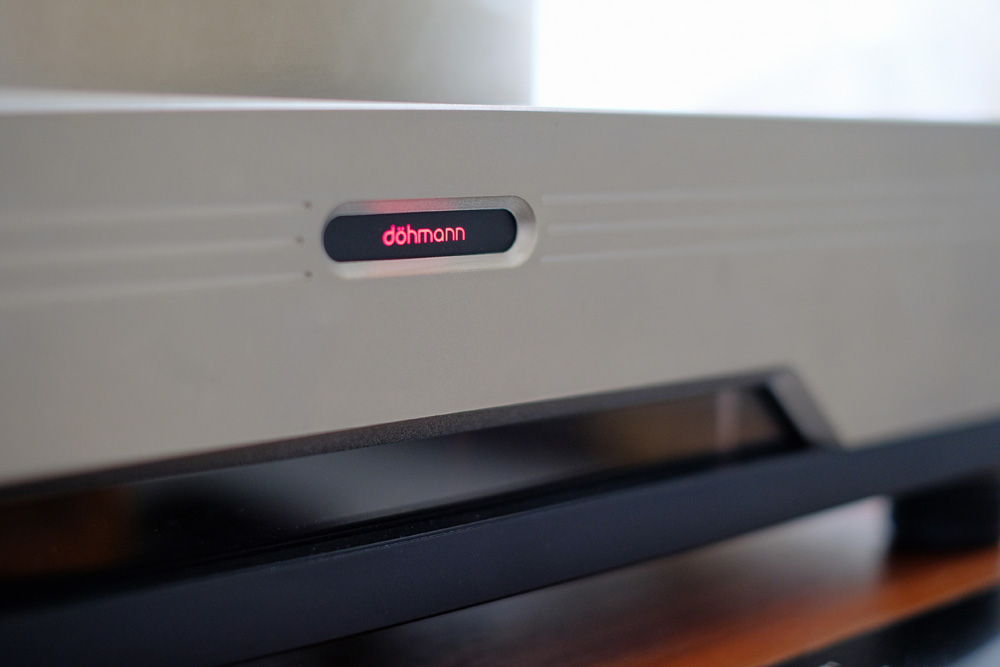
The gritty, wailing vocals in “Sugar Sugar Sugar” and “Up Jumped the Devil” from Nick Cave and The Bad Seeds’ Tender Prey LP cut through with accuracy and superb separation. Dynamic contrasts were stunningly real, with the authority of Cave’s fortes and the power pulses of the music passed on from H2 to the amplification and speakers in a most authoritative manner. This is meant to be incisive, even confronting material and if the source is deficient in terms of its resolution and dynamic powers, Cave’s expressive sentiments would be lost in the musical mayhem, especially in light of the somewhat pedestrian overall production. Not with the Helix Two. The turntable package is precise and unwavering in its generous presentation of pure music with all its scars and pain intact. True, honest communication here…
The Cure’s Standing on a Beach shows a kaleidoscope of the band’s varied singles, from its early guitar-based music right up to their mid-life dreamy pensiveness a few years prior to their disbandment (but recently revived and toured in Australia). Again, all the anguish and sorrow in Robert Smith’s vocals on “Charlotte Sometimes” is clearly interconnected with the music, the H2 separating the complex strands while leaving the feel intact. On one of my favourite early tracks “Jumping Someone Else’s Train”, the rhythm of the fast-paced track is stunning… this is yet another of the H2’s most excellent qualities.
David Oistrakh’s handling of Sibelius’ Concerto in D Minor for Violin and Orchestra, The Swan of Tuonela, with Eugene Ormandy conducting the Philadelphia Orchestra, showed the master violinist’s exquisite musicianship by retaining and displaying all of the detail and intricacies of his technique. The violin’s tone from lowest to highest notes was precisely reproduced with accurate mix of string and wooden body. Ditto for the orchestra’s grandeur which spanned across the room and well behind the speakers in a massive soundfield.
The atmospherically-mellow tones of David Sylvian from Japan’s Exorcising Ghosts – in particular “The Other Side of Life” and “Ghosts” tracks – is communicated with all its compelling emotive power. Sylvian’s voice undulates in tone and oscillates in intensity, surging back and forth, and H2 captures all the ripples, creating a powerful swell as the music escalates to the chorus. Despite it being a 1980’s recording – and although decent, it’s not brilliant – with the H2 you forget about the OCD aspects of production and you are swept away with the beauty and poetry of the music. Science meets art. That, for me, is what exceptional Hi-Fi is all about.
Carbon Foot Print
A few weeks later, Mark Döhmann once again made the trip to SoundStage! Australia HQ in order to swap the standard armboard for the optional upgrade carbon fibre (CF for short) armboard. The exercise was simple enough, only taking a few minutes as far as the refit with a subsequent re-tweak of all the associated parameters.
Playing the same track from Grace Jones’ Nightclubbing which we spun just prior to the swap served as a clear and undeniable indication of the powers of the CF armboard. As good as the performance was prior, the CF upgrade just brought that extra layer of micro-detail to the forefront. It was a slightly more nuanced presentation, not just in terms of the minutiae but also in the finer tonal cues of low level information. The extra clarity in those areas brought about an added believability to the gradations and modulations of the intricacies in the music.
Although subtle, I’m convinced there was also an improvement on the already sublime rhythmic qualities of the metal armboard. Fine pace and bass tightness, with added nuance, were the CF armboard’s by-products. Overall, finances permitting, I would recommend the upgrade to the carbon fibre armboard as being a solid investment in terms of performance.
Conclusion
I had the pleasure of having the Helix Two turntable in situ for more than two months. During that time it functioned flawlessly. All parameters and settings remained solidly locked-in, further evidence that, tonearm notwithstanding, once set-up at the time of purchase you’ll need not fuss again unless you wish to.
With the convenience and simplicity of its operation aside, you’ll get on with enjoying the pleasures of the Helix Two’s considerable sonic qualities. Standouts were the ‘table’s toe-tapping PRAT (the much debated Pace, Rhythm and Timing phenomena), its superb handling of low frequencies which were always nuanced, powerful and precise, the accuracy of its tonal capabilities and the literally stunning dynamic expression, among many other things (some of these being also a function of a well-matched ‘table, tonearm and cartridge package).
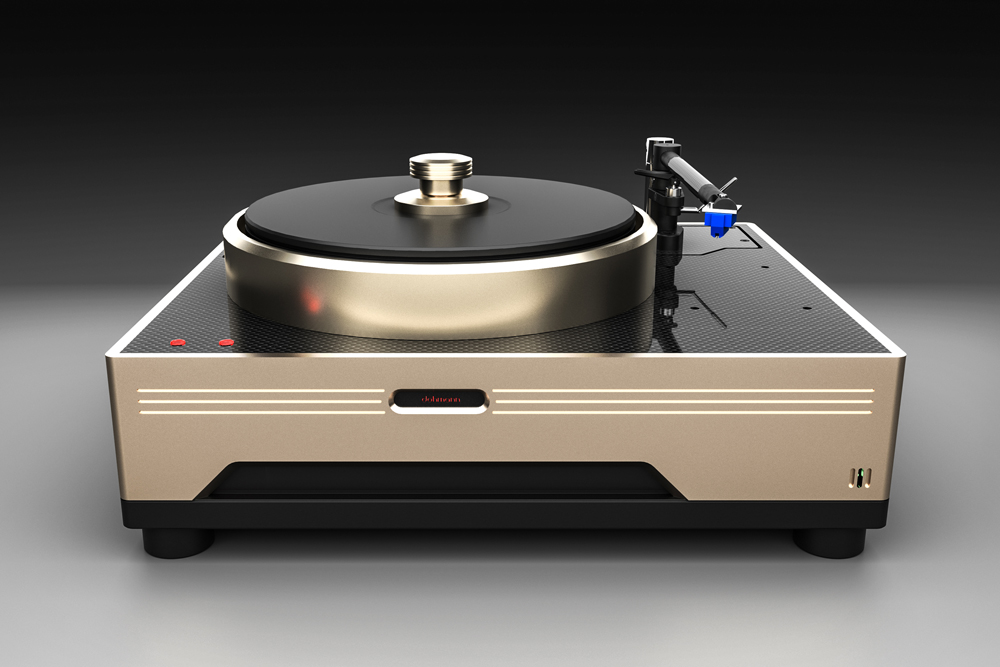
For those with the resources to consider an analogue rig in excess of AU$60K (or even more depending on your choice of tonearm, cartridge and phono stage), the Döhmann Audio Helix Two will please for many years – it’s built to heirloom-lasting standards – without provoking a desire to explore further afield (unless the attraction of Helix One’s dual arm capability is an irresistible temptation). In addition, it will provide the sonic pleasures of packages costing well above it, even ones hovering around the century $ mark. In the world of high-end audio, many would see that as good value, relatively …
However, the most important thing for this writer – and I believe all you readers out there too – is that the Helix Two will keep you listening to music and re-experiencing its elevating pleasures. Mr Döhmann and his team have created yet another Aussie engineering and artistic marvel, further compounding Australia’s rep for awe-inspiring natural and man-made wonders…
… Edgar Kramer
This email address is being protected from spambots. You need JavaScript enabled to view it.
Associated Equipment
- Speakers — Wilson Audio Alexia Series 2, Axis Loudspeakers VoiceBox S (nearfield monitor), Vermouth Audio Little Luccas Mk.II
- Amplifier — Gryphon Audio Antileon EVO
- Preamplifier — Supratek Cortese, Lightspeed Attenuator LDR passive
- Sources — Digital: Yamaha CD-S2100 transport, Chord Electronics Hugo M Scaler, Totaldac d1-core DAC, Asus PC as Roon Core. Analogue: Michell Engineering Orbe with Gert Pedersen Level 3 modifications and Origin Live Ultra upgraded motor, Trans-Fi Terminator air bearing linear-tracking arm, Shelter Harmony cartridge, Supratek Cortese & REDGUM Audio RGPH2 phono stages
- Processor — DEQX PreMate
- Cables — sILENzIO loom, Vermouth Audio Black Pearl Mk.II loom
- Audio Rack — SGR Audio Statement Model V
- Miscellaneous — Les Davis Audio Viscoelastic CLD discs, VRC Vinyl Record Cleaning system
Döhmann Audio Helix Two Turntable
Price: Turntable only – AU$40,500 (Black or Silver), AU$45,000 (Titanium)
Warranty: Five Years
Australian Distributor: Nirvana Sound
+61 409 514 914
www.nirvanasound.com.au
Döhmann Audio
Unit 4, 1-7 Friars Road
Moorabbin VIC 3189
Australia
+61 409 514 914
www.dohmannaudio.com







